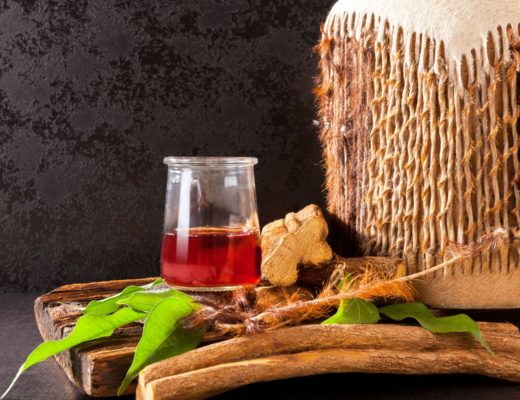Introduction
Ayahuasca, or “the vine of the soul”, is a ceremonial preparation that has sparked both earlier and later controversy as one of the world’s most rewarding psychoactive substances.
While Ayahuasca is a “psychoactive” beverage from a scientific and conceptual standpoint, it represents a sacrament for the shamas of the Amazon Basin, who regard it as a “teacher plant” or “master plant.”
Master or teacher plants and trees are herbs that teach, transmit protection, guidance and sacred knowledge to those who use them. Moreover, they are deemed to promote creative thinking and visual creativity, enabling the seeker to establish a connection with the spiritual world, primarily used in divination and healing practices.
For this reason, Ayahuasca falls into the category of “Entheogens”.
Thus, an entheogen is a substance that induces inspiration or ideas, often religiously or spiritually, the source of experience coming from within.
Ayahuasca is obtained primarily from the bark of the liane Banisteriopsis caapi, with additives from other species, most notably Psychotria viridis, also known as Chacruna, which the indigenous peoples have used for a variety of purposes. Both plants are “teacher plants” in their own kind.
Banisteriopsis caapi is a large climbing shrub ( vine ) with woody stems that belongs to the Malpighiaceae family. The bark, leaves, and twigs are the reservoirs of the psychoactive elements rendered in the Ayahuasca brew. The vine is indigenous to Northern and western S. America – Brazil, Bolivia, Peru, Colombia, Ecuador, Venezuela.
It is widely utilized in the Amazon jungle as a shamanic vehicle for connecting with the spiritual realm, inducing healing and recreational benefits.
It contains psychoactive chemicals like dimethyltryptamine (DMT) and alkaloids like harmine, tetrahydroharmine (THH), and harmaline, which function as monoamine-oxidase-A (MAO-A) inhibitors, increasing norepinephrine (NE), serotonin (5-HT), and dopamine (DA) levels by blocking the monoamine oxidase (MAO).
Psychotria viridis is a slender, evergreen shrub or small tree of the Rubiaceae family with a broad or flat canopy.
It is widespread throughout South America (Brazil, Bolivia, Peru, Ecuador, Colombia, Venezuela); the Caribbean (Cuba, Dominican Republic, Haiti); and Central America (Panama to Mexico).
The leaves of this plant are utilized as an admixture in the preparation of Ayahuasca. They contain N,N-dimethyltryptamine (DMT), an indole alkaloid responsible for the plant’s psychedelic qualities.
The potent compound N,N,-dimethyltryptamine, has been shown to enhance the action of the β-carboline alkaloids harmine, harmaline and tetrahydroharmine (THH) that are found in the Banisteriopsi caapi.
Other plants such as Diplopterys cabrerana (Chaliponga), Mimosa hostilis (Jurema), Tetrapterys mucronata, and even the African herb Peganum harmala (Syrian rue) have been utilized in Ayahuasca beverages; however, the Syrian rue shares a similar molecule with the Amazonian entheogen and has been used in Eurasia and North Africa for thousands of years for the same purposes.
Etymology
Etymologically, “ayahuasca” is a Quechua term for the hallucinogenic concoction “Ayawaska” originating in the Amazon Basin of South America. It’s also known as “caapi” or “yajé” in Colombia, “Nate” in Ecuador, and “hoasca” in Brazil. The word “ayahuasca” comes from the Quechua words “aya”, which means spirit (world of death, the other world) and “huasca”, which implies liane or vine (means rope) and can be translated as “vine of the soul” in English.
History
Prior to the colonial period, indigenous people have used natural treatments with psychoactive effects as companions in religious trances and curative ceremonies. These persons are facilitators of spiritual trances and curing rituals known as shamans.
The shaman figure is important to explain the origins of the drink consumed while under the power of the herb.
During a shamanic ceremony, participants enter altered states of consciousness and build relationships with spiritual entities to serve their communities by diagnosing and treating ailments, solving riddles, and making predictions.
The use of Ayahuasca under various names is a widely practiced activity among indigenous cultures unique to the Amazon Basin. Presumably, these activities were well established in pre-Columbian periods and may have been known to the earliest human occupants of the area. The ceramics and other artifacts from Ecuador gave proof that this technique dated back to 2000 B.C. Widespread distribution among several Amazonian tribes also indicates its antiquity.
For the shamans from Colombia, Ayahuasca falls into the category of “visualizers,” not hallucinogens.
Ayahuasca has traditionally been used as a therapeutic aid by native healers in the Orinoco and Amazon basins for many reasons, including treating psychological diseases in patients, with some experimentally and clinically proven beneficial outcomes in the modern age.
Following European contact, significant genetic overlapping and adoption of indigenous beliefs arose, and Ayahuasca, along with an implicit pharmacopeia of other therapeutic plants, gradually got absorbed into the ethnomedical traditions of these mixed communities.
Today, Ayahuasca is an essential part of ethnomedicine and shamanism in indigenous Mestizo tribes in Peru, Colombia, and Ecuador.
Several claims support that the scientific study of Ayahuasca began with English botanist Richard Spruce, who traveled extensively in the Brazilian, Venezuelan, and Ecuadorian Amazons between 1849 and 1864 to record the plant species found there.
Method of preparation
Ayahuasca is prepared in a variety of ways.
Depending on the quantity of beverage and its refinement, the decoction procedure may take many days until a tea with a hazel-colored brew and a bitter taste is obtained.
The bark of Banisteriopsis caapi and other plant components are collected, sliced, rinsed, and macerated in water before being crushed with a wooden hammer and carefully placed in a cauldron, mixed with washed Chacruna leaves. Then, after adding enough water to cover the plant material, the mixture is cooked and concentrated for at least 8 hours to yield a sufficient amount of liquid extract.
In some Amazonian ceremonies, hymns and chants are performed, and the drink is prepared in a ritualistic and reverent manner. Men and women can share the tasks: women clean the bush leaves— an association with femininity and light; men work with the vine, correlated with masculinity and strength.
Mechanism of action of Ayahuasca
Ayahuasca contains alkaloids such as β-carbolines and dimethyltryptamines that inhibit monoamine oxidase and activate the 5-HT2A (5-hydroxytryptamine) receptor resulting in a visionary experience for the users.
The alkaloids harmine and harmaline are responsible for Banisteriopsis’ psychoactive properties. These beta-carboline alkaloids inhibit monamine oxidase, allowing the N,N-dimethyltryptamine found in Psychotria leaves to pass through the blood–brain barrier unaltered.
Therapeutic uses and benefits
Ayahuasca use dates back to the pre-Columbian period when it was used in religious cults by various South American populations living in the Brazilian Amazon and the region between Panama and Peru. Considered the cornerstone of Amazon medicine, it contains a number of psychotropic chemicals capable of inducing visionary experiences in healers, shamans, and participants or members of the community.
The popularity of Ayahuasca has resulted in a significant number of scientific articles in a variety of fields, including sociology, psychology, psychiatry, neurology, pharmacology, toxicology, and religion.
Ayahuasca’s powerful curative properties have been found to treat addictions in various Latin American countries, including Peru, Brazil, Ecuador, Colombia, Argentina, Chile, and Mexico.
In Ecuador, the Quecha people believe that consuming Ayahuasca allows the soul to roam, allowing them to interpret the enemy’s intentions, pay visits to friendly tribes, and assure the love of their women.
Ayahuasca began to be used outside of typical indigenous contexts in the twentieth century in places like Brazil, where the drink became critical to the spiritual rites of growing syncretistic religious groupings. In the 1970s, organizations such as the Santo Daime, Barquinha, and Unio do Vegetal merged elements of African spiritualism, esoteric mysticism, Christian liturgy, and indigenous traditions to create new ayahuasca drinking practices that swept throughout metropolitan Brazil.
Healers utilize Ayahuasca to cure psychological and physiological issues in patients who first experience nausea, vomiting, or diarrhea after consuming it.
Therefore, Ayahuasca’s purgative effects are frequently seen as tonic rather than poisonous. Daimistas, adherents of the Santo Daime faith who employ Ayahuasca in their ceremonies, believe that the medicinal characteristics of the plant can help people release repressed emotions through vomiting or diarrhea.
Ayahuasca’s therapeutic potential extends beyond its DMT content and the neurobiological level.
Additionally, researchers show that the -carboline alkaloids themselves possess pharmacological qualities, including antihelmintic, antibacterial, and vasorelaxant activity, as well as ethno-psychiatric, socio-psychotherapeutic, and rehabilitative properties.
Human clinical research demonstrated that Ayahuasca modulates the quantity and arrangement of blood immune cells, increasing the consumer’s immunological-mediated antiviral and anti-tumor immunity of the user. In preliminary studies, the decoction may have promise anti-cancer activity in further clinical trials. Finally, DMT may also be an adaptogen, helping the body to survive acute hypoxia or persistent oxidative stress.
Harmala alkaloids have substantial psychedelic effects and operate as central nervous system stimulants. Additionally, an antidepressant effect of Ayahuasca has been ascribed to these alkaloids, commensurate with ethnographic observations that many indigenous users of Ayahuasca give sacramental respect to the B. caapi than to the DMT-containing plant elements.
Conclusion
For several thousand years, substances, primarily plants that induce an altered state of consciousness, have been utilized ritually in a wide variety of societies throughout the world. Their application has included religious, recreational, and therapeutic purposes.
Throughout the Amazon Basin, the use of Ayahuasca has remained deeply rooted in tribal folklore and belief system, to the point where modern investigators, who define Ayahuasca as a substance with transcendent pharmacological and personal implications, have concluded that its use dates back to the region’s earliest aboriginal inhabitants.
Albert Hofmann and Richard Evans Schultes report in “Plants of the Gods,” a book renowned for its descriptions of psychoactive plants that: “the drinking of Ayahuasca facilitates “a return ‘to the maternal womb, to the source and origin of all things’ and participants see ‘all the tribal divinities, the creation of the universe, the first human beings and animals, and even the establishment of the social order.”





No Comments